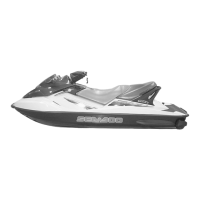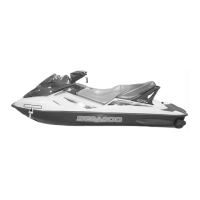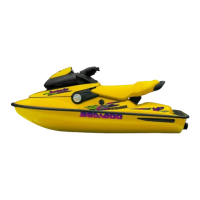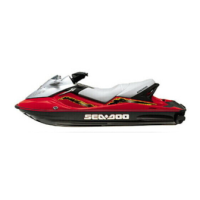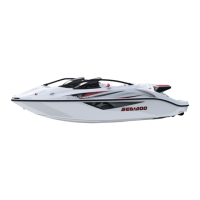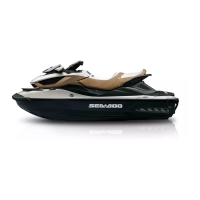Section04ENGINEMANAGEMENT(15034-TEC)
Subsection 03 (COMPONENT INSPECTION, REPLACEMENT AND ADJUSTMENT)
CAUTION: Improper torque might prevent sen-
sor to work properly and lead engine to severe
damage of internal components.
Replug connector.
OIL PRESSURE SENSOR (OPS)
1
R1503motr194A
TYPICAL
1. OPS
Oil Pressure Test
First, carefully check the condition of the connec-
tor terminals. Clean to remove dirt and corrosion
that coud affect proper operation of the sensor.
IMPORTANT: Do not apply dielectric grease on
terminal.
To check the function of the oil pressure sensor,
an oil pressure test has to be performed. Refer
to LUBRICATION SYSTEM in the 1503 4-TEC EN-
GINE SHOP MANUAL.
If the engine oil pressure is good, the OIL mes-
sage in the cluster is present and the beeper is
ON, check the resistance of the OPS while engine
is off and while engine is running. A dynamic test
of the circuit can also be conducted.
Resistance Test
Disconnect the connector from the OPS and use
a multimeter to check the resistance between
OPS terminal and engine ground while eng
ine is
stopped (without oil pressure) and wh
ile engine
is running (with oil pressure).
When engine is stopped the resistance is infinitely
high (normally open switch).
When engine is running and the oil pressure reach-
es 180 - 220 kPa (26 - 32 PSI), the resistance of the
OPS is close to 0
.
If resistance values are incorrect, replace OPS.
If the values are correct, check the continuity of
the wiring harness.
Disconnect the ECM connector A from the ECM
and check continuity of circuit 6.
If wiring harness is good, try a new ECM. Refer to
ECM AND MPEM in this section.
Otherwise, repair the connector or replace the
wiring harness between ECM connector and OPS.
Dynamic Test
First, ensure an oil pressure test is performed and
the pressure is within specifications.
Disconnect the connector from the oil pressure
sensor (OPS).
Start the engine THEN ground the OPS connector.
If the problem goes away (no OIL message in the
cluster and beeper is OFF), either the oil pressure
sensor (OPS) is defective or there is a bad connec-
tion with the sensor.
If the problem is still there (OIL message in the
cluster and beeper is ON), there is a malfunction
in the harness (open circuit).
TOPS VALVE
The valve is turned on as soon as safety lanyard
is installed on its post. The valve opening allows
ventilation of crankcase.
TheOSPSmonitorsthepressuretodetectamal-
function of this valve. If pressure rises above a
preset threshold (40 kPa (6 PSI)), the valve is re-en-
ergized again and if it fails, a fault code is generat-
ed.
The TOPS switch, located besides the MPEM (on
MPEM bracket), monitors the watercraft position.
If the watercraft rolls above a preset threshold (or
tips over) the switch opens and the ECM clos-
es the valve to prevent oil in engine crankcase to
flow towards intake manifold. Besides, the en-
gine RPM will be gradually reduced then engine
will be stopped.
128 smr2005-013
